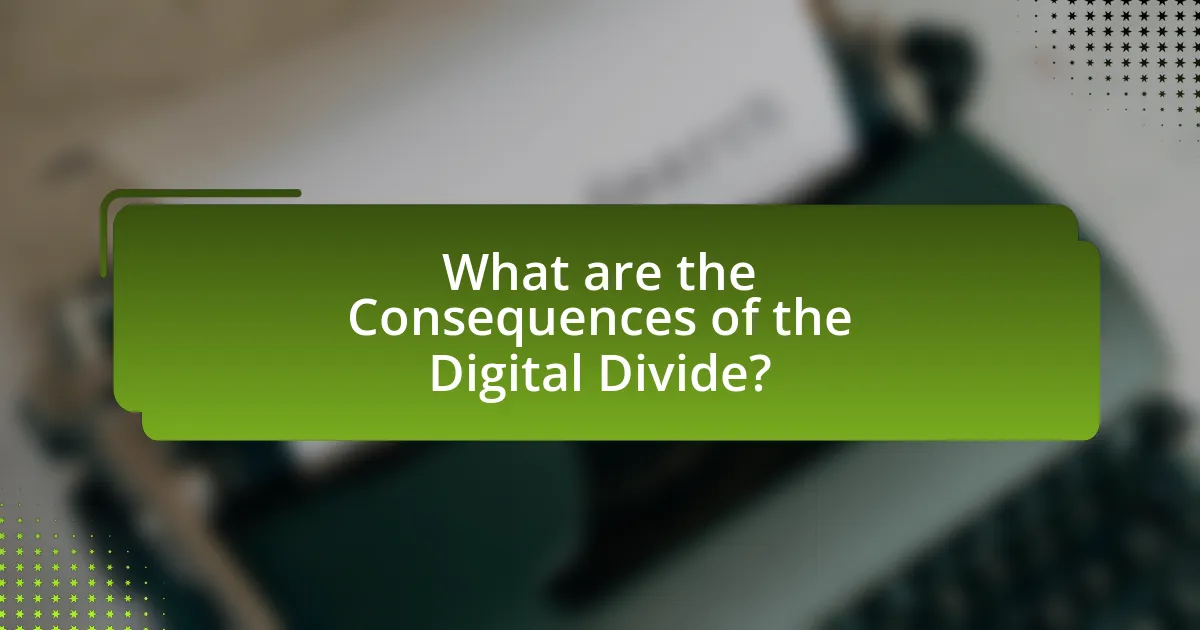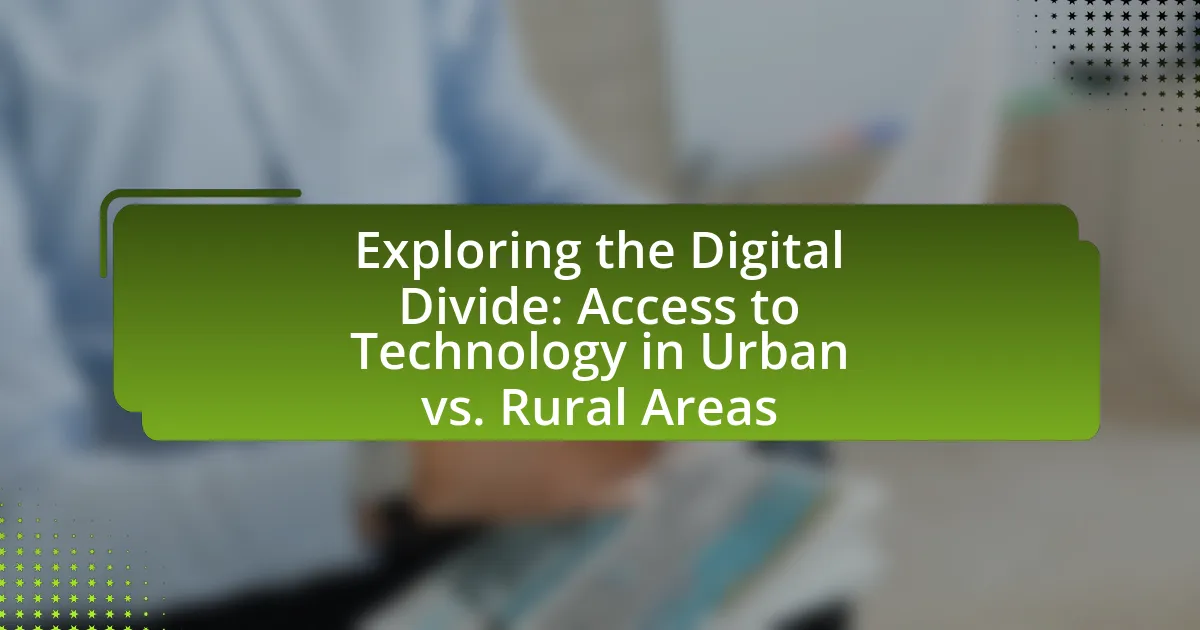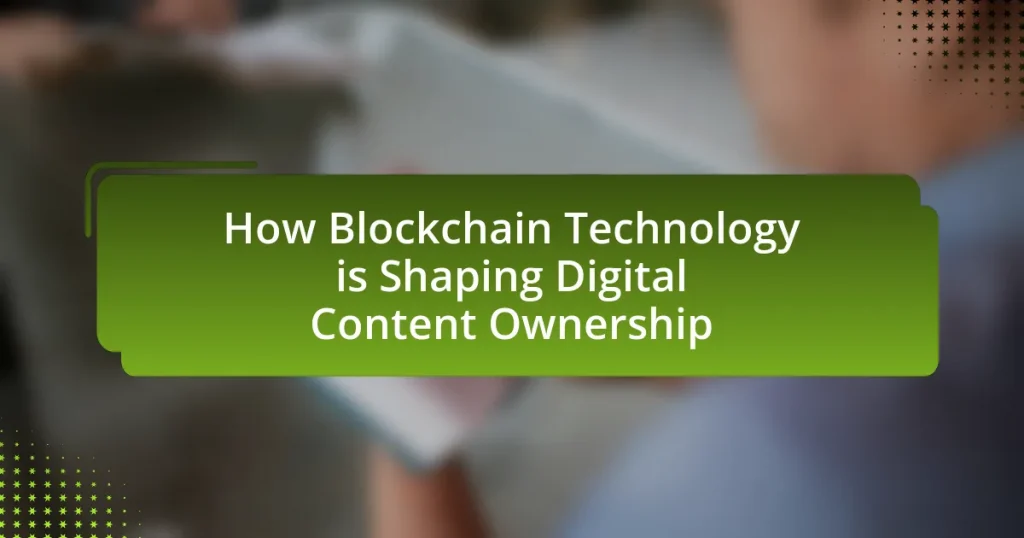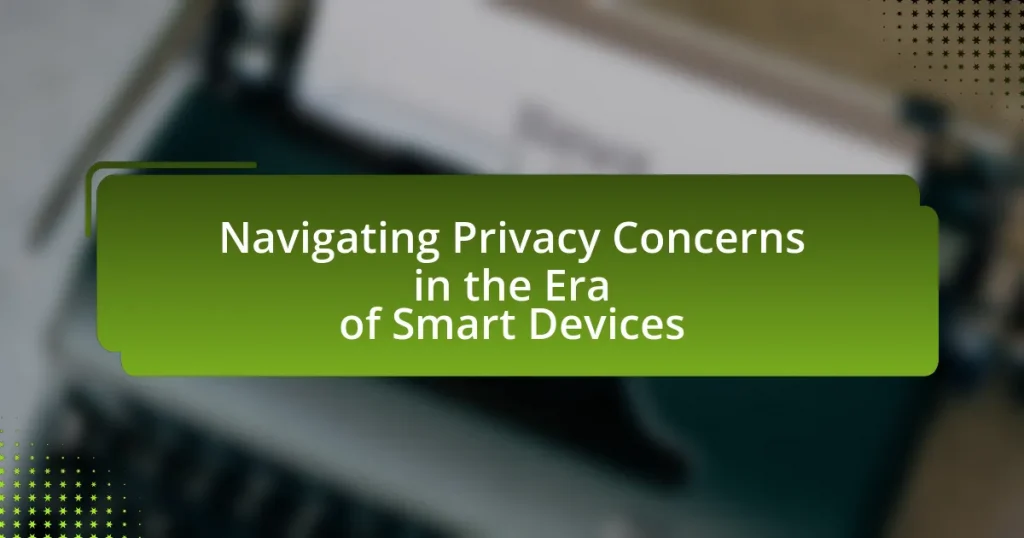The Digital Divide refers to the disparity in access to modern information and communication technology between individuals and communities, particularly highlighting the differences between urban and rural areas. This article examines the factors contributing to the Digital Divide, including infrastructure, economic resources, and educational opportunities, and presents key statistics illustrating the gap in technology access. It discusses the implications of this divide on essential services, education, and economic opportunities, particularly for rural populations, and explores potential solutions and initiatives aimed at bridging the gap. The article emphasizes the importance of addressing these disparities to promote social inclusion and equitable access to technology.

What is the Digital Divide and Why Does It Matter?
The Digital Divide refers to the gap between individuals and communities that have access to modern information and communication technology and those that do not. This divide matters because it affects economic opportunities, educational access, and social inclusion, particularly in urban versus rural areas. For instance, according to the Federal Communications Commission, as of 2021, approximately 14 million Americans lack access to broadband internet, with rural areas disproportionately affected, limiting their ability to participate in the digital economy and access essential services.
How is the Digital Divide defined in the context of urban and rural areas?
The Digital Divide in the context of urban and rural areas is defined as the disparity in access to digital technologies and the internet between these two geographic regions. Urban areas typically have higher internet penetration rates, better infrastructure, and more technological resources, resulting in greater access to digital services. In contrast, rural areas often face challenges such as limited broadband availability, lower speeds, and fewer technological resources, which contribute to a significant gap in digital access. According to the Federal Communications Commission, as of 2021, approximately 14.5 million Americans in rural areas lack access to high-speed internet, highlighting the stark contrast in connectivity between urban and rural populations.
What factors contribute to the Digital Divide between urban and rural populations?
The Digital Divide between urban and rural populations is primarily influenced by disparities in infrastructure, economic resources, and educational opportunities. Urban areas typically have better internet infrastructure, including higher broadband availability and faster speeds, which facilitates access to technology. In contrast, rural regions often face challenges such as limited connectivity options and lower investment in telecommunications infrastructure.
Economic resources also play a significant role; urban populations generally have higher income levels, enabling greater access to devices and technology services. According to the Federal Communications Commission, as of 2021, approximately 14% of rural Americans lack access to broadband, compared to only 1% in urban areas.
Additionally, educational opportunities in urban settings often include more comprehensive digital literacy programs, equipping residents with the skills needed to utilize technology effectively. In rural areas, limited access to such educational resources can hinder the ability to engage with digital platforms. These factors collectively contribute to the ongoing Digital Divide between urban and rural populations.
How does the Digital Divide impact access to essential services?
The Digital Divide significantly limits access to essential services, particularly for individuals in rural areas who lack reliable internet connectivity. This disparity affects their ability to access healthcare, education, and government services online. For instance, a report by the Federal Communications Commission (FCC) indicates that approximately 19 million Americans in rural areas do not have access to broadband internet, which is crucial for telehealth services and online learning platforms. Consequently, this lack of access exacerbates inequalities, as those without reliable internet are unable to benefit from essential services that increasingly rely on digital platforms.
What are the key statistics related to technology access in urban vs. rural areas?
Urban areas have significantly higher technology access compared to rural areas, with approximately 98% of urban residents having access to high-speed internet, while only about 65% of rural residents enjoy the same access. This disparity is further highlighted by the fact that urban areas typically have more than double the number of broadband providers compared to rural regions, leading to increased competition and better service options. Additionally, a report from the Federal Communications Commission indicates that rural Americans are more likely to rely on mobile data for internet access, with about 30% of rural households lacking a fixed broadband connection, compared to just 1% in urban settings. These statistics underscore the persistent digital divide between urban and rural populations in terms of technology access.
How do internet penetration rates differ between urban and rural regions?
Internet penetration rates are significantly higher in urban regions compared to rural areas. For instance, as of 2021, urban areas in the United States reported internet penetration rates exceeding 90%, while rural areas lagged behind with rates around 65%. This disparity is attributed to factors such as infrastructure investment, population density, and access to high-speed broadband services, which are more prevalent in urban settings. Studies, including those from the Federal Communications Commission, highlight that urban regions benefit from better connectivity options, leading to a pronounced digital divide between urban and rural populations.
What are the disparities in device ownership among urban and rural residents?
Urban residents generally have higher device ownership compared to rural residents. For instance, a 2021 Pew Research Center study found that 95% of urban households own a smartphone, while only 85% of rural households report the same. Additionally, urban areas often have better access to high-speed internet, which correlates with higher ownership of devices such as laptops and tablets. In contrast, rural residents face challenges such as limited internet infrastructure and economic factors, leading to lower rates of device ownership.
What role does socioeconomic status play in the Digital Divide?
Socioeconomic status significantly influences the Digital Divide by determining access to technology and the internet. Individuals from higher socioeconomic backgrounds typically have better access to digital resources, including high-speed internet and devices, compared to those from lower socioeconomic backgrounds. For instance, a report by the Pew Research Center in 2021 indicated that 93% of households earning over $75,000 annually had broadband internet, while only 63% of households earning less than $30,000 had similar access. This disparity highlights how socioeconomic factors create barriers to technology access, exacerbating inequalities in education, employment, and information access.
How does income level affect technology access in urban vs. rural settings?
Income level significantly affects technology access, with urban areas generally having better access compared to rural settings. In urban environments, higher income levels correlate with increased availability of high-speed internet and advanced technology, as urban infrastructure supports more service providers and competitive pricing. Conversely, rural areas often face limited internet service options and higher costs due to lower population density, which can hinder access to technology. According to the Federal Communications Commission, as of 2021, approximately 14% of rural Americans lack access to broadband, compared to only 1% in urban areas, highlighting the disparity driven by income and geographic location.
What educational factors contribute to the Digital Divide?
Educational factors that contribute to the Digital Divide include disparities in access to technology, differences in digital literacy, and variations in educational resources. Disparities in access to technology arise when students in rural areas have limited availability of computers and high-speed internet compared to their urban counterparts, which affects their ability to engage with digital learning tools. Differences in digital literacy stem from varying levels of training and exposure to technology, where students in urban schools often receive more comprehensive technology education than those in rural settings. Variations in educational resources, such as funding for technology programs and teacher training, further exacerbate the divide, as schools in economically disadvantaged areas may lack the necessary support to implement effective technology integration. These factors collectively hinder equitable access to digital education, reinforcing the Digital Divide.

What are the Consequences of the Digital Divide?
The consequences of the digital divide include increased inequality in access to information, education, and economic opportunities. Individuals in rural areas often lack reliable internet access, which limits their ability to participate in online learning and remote work, leading to a widening gap in educational attainment and job prospects compared to their urban counterparts. According to a 2021 report by the Federal Communications Commission, approximately 14.5 million Americans lack access to broadband internet, disproportionately affecting rural communities. This disparity not only hinders personal and professional growth but also exacerbates social inequalities, as those without digital access are less able to engage in civic activities and access essential services.
How does the Digital Divide affect education in urban and rural areas?
The Digital Divide significantly impacts education in urban and rural areas by creating disparities in access to technology and internet connectivity. In urban areas, students typically have better access to high-speed internet and digital resources, which facilitates online learning and access to educational materials. Conversely, rural areas often experience limited internet availability and slower connections, hindering students’ ability to engage in digital learning environments. According to the Federal Communications Commission, as of 2021, approximately 14 million Americans lack access to broadband internet, with rural communities disproportionately affected. This lack of access can lead to lower educational outcomes, as students in rural areas may struggle to complete assignments, participate in virtual classes, or access online resources compared to their urban counterparts.
What challenges do students face in rural areas regarding technology access?
Students in rural areas face significant challenges regarding technology access, primarily due to limited internet connectivity and inadequate infrastructure. According to the Federal Communications Commission, approximately 14 million Americans lack access to broadband, with rural areas disproportionately affected. This lack of reliable internet hampers students’ ability to engage in online learning, access educational resources, and participate in digital communication. Additionally, rural schools often have fewer technological resources, such as computers and software, which further limits students’ exposure to essential digital skills. These factors collectively contribute to a widening educational gap between rural and urban students.
How do urban students benefit from better technology access?
Urban students benefit from better technology access by enhancing their educational opportunities and improving academic performance. Access to technology facilitates personalized learning experiences, enabling students to engage with interactive educational resources and online courses that cater to their individual learning styles. Research indicates that students with access to technology score higher on standardized tests; for instance, a study by the Pew Research Center found that 87% of teachers believe technology positively impacts student learning. Furthermore, technology access fosters collaboration among students, allowing them to work on group projects and communicate effectively, which is essential in developing critical thinking and problem-solving skills.
What impact does the Digital Divide have on economic opportunities?
The Digital Divide significantly limits economic opportunities for individuals and communities lacking access to technology. This divide creates disparities in job access, education, and entrepreneurial ventures, particularly in rural areas where internet connectivity is often inadequate. For instance, a report by the Federal Communications Commission (FCC) indicates that nearly 25% of rural Americans lack access to high-speed internet, compared to only 1.5% in urban areas. This lack of connectivity restricts access to online job listings, remote work options, and digital skills training, ultimately hindering economic mobility and growth in these regions.
How does limited access to technology hinder job prospects in rural areas?
Limited access to technology significantly hinders job prospects in rural areas by restricting individuals’ ability to seek employment, acquire skills, and connect with potential employers. In rural regions, where internet connectivity and access to digital tools are often inadequate, job seekers face challenges in applying for positions, participating in online training programs, and utilizing job search platforms. According to a report by the Federal Communications Commission, approximately 25% of rural Americans lack access to high-speed internet, which directly impacts their ability to engage in the modern job market. This digital divide results in fewer job opportunities, lower wages, and increased economic disparity compared to urban areas where technology access is more prevalent.
What advantages do urban residents have in terms of employment due to technology access?
Urban residents benefit from enhanced employment opportunities due to greater access to technology. This access facilitates remote work options, allowing individuals to apply for jobs beyond their local area, thus expanding their employment prospects. Additionally, urban areas often have better internet infrastructure, enabling residents to utilize online job platforms and resources effectively. According to the Federal Communications Commission, urban areas have broadband access rates exceeding 90%, compared to rural areas, which often fall below 70%. This disparity in technology access directly correlates with higher employment rates and job diversity in urban settings.
What are the health implications of the Digital Divide?
The health implications of the Digital Divide include increased disparities in access to healthcare information and services, leading to poorer health outcomes for those without adequate technology access. Individuals in rural areas often face challenges such as limited access to telehealth services, which can result in delayed diagnoses and treatment. A study by the Pew Research Center found that 41% of rural Americans reported difficulties in accessing health information online, compared to 24% of urban residents. This gap can exacerbate existing health inequalities, as those without reliable internet access may miss out on critical health resources, preventive care, and timely medical advice.
How does technology access influence healthcare availability in rural areas?
Technology access significantly influences healthcare availability in rural areas by enabling telemedicine services, which bridge the gap between patients and healthcare providers. In rural regions, where medical facilities are often scarce, telemedicine allows patients to consult with healthcare professionals remotely, reducing travel time and costs. According to a study published in the Journal of Rural Health, telehealth services increased access to care by 38% in rural populations, demonstrating that improved technology access directly correlates with enhanced healthcare availability. Furthermore, access to electronic health records and mobile health applications facilitates better management of patient information and chronic diseases, further supporting the healthcare infrastructure in these areas.
What telehealth opportunities are more accessible in urban settings?
Telehealth opportunities that are more accessible in urban settings include virtual consultations, remote monitoring, and mental health services. Urban areas typically have better internet connectivity and access to technology, facilitating these services. For instance, a study by the Pew Research Center indicates that 90% of urban residents have access to high-speed internet, compared to only 65% in rural areas. This connectivity enables urban populations to utilize telehealth platforms effectively, leading to increased healthcare access and improved patient outcomes.

What Solutions Exist to Bridge the Digital Divide?
Solutions to bridge the digital divide include expanding broadband infrastructure, providing affordable internet access, and enhancing digital literacy programs. Expanding broadband infrastructure involves government and private sector investments to ensure high-speed internet reaches underserved urban and rural areas, as evidenced by the Federal Communications Commission’s (FCC) initiatives that aim to connect millions of Americans. Providing affordable internet access can be achieved through subsidies or low-cost plans offered by internet service providers, which have been shown to increase connectivity in low-income households. Enhancing digital literacy programs equips individuals with the skills necessary to effectively use technology, as demonstrated by various community initiatives that have successfully improved digital skills among participants, leading to better job opportunities and access to information.
What initiatives are being implemented to improve technology access in rural areas?
Various initiatives are being implemented to improve technology access in rural areas, including government programs, nonprofit efforts, and private sector partnerships. For instance, the Federal Communications Commission (FCC) has launched the Rural Digital Opportunity Fund, which allocates $20.4 billion to expand broadband access in underserved rural communities. Additionally, organizations like the National Rural Electric Cooperative Association are working to provide high-speed internet through partnerships with local electric cooperatives. These initiatives aim to bridge the digital divide by enhancing connectivity, thereby enabling better access to education, healthcare, and economic opportunities in rural regions.
How are government programs addressing the Digital Divide?
Government programs are addressing the Digital Divide by implementing initiatives that enhance internet access and digital literacy, particularly in underserved urban and rural areas. For example, the Federal Communications Commission (FCC) has established the Emergency Broadband Benefit program, which provides subsidies to low-income households for internet service, thereby increasing connectivity. Additionally, the Infrastructure Investment and Jobs Act allocates $65 billion to expand broadband infrastructure, aiming to close the gap in internet access between urban and rural populations. These efforts are supported by data indicating that approximately 14 million Americans lack access to high-speed internet, highlighting the necessity for targeted government intervention.
What role do non-profit organizations play in bridging the gap?
Non-profit organizations play a crucial role in bridging the digital divide by providing access to technology and digital literacy programs in underserved communities. These organizations often focus on areas where government and private sector initiatives fall short, particularly in rural regions where internet access and technological resources are limited. For instance, according to the Federal Communications Commission, approximately 19 million Americans lack access to high-speed internet, with a significant concentration in rural areas. Non-profits address this gap by establishing community tech hubs, offering training sessions, and distributing devices to enhance digital skills. Their efforts not only improve access to technology but also empower individuals with the skills necessary to navigate the digital landscape effectively.
How can communities work together to enhance technology access?
Communities can enhance technology access by collaborating to establish shared resources, such as community internet hubs and technology training programs. For instance, local governments, schools, and non-profit organizations can partner to create free Wi-Fi zones in public spaces, which has been shown to increase internet accessibility in underserved areas. According to a report by the Pew Research Center, communities that implement such initiatives see a significant reduction in the digital divide, as they provide essential connectivity to residents who may lack access at home. Additionally, organizing workshops that teach digital literacy skills can empower individuals to utilize technology effectively, further bridging the gap in technology access.
What partnerships can be formed between urban and rural areas to share resources?
Urban and rural areas can form partnerships through technology-sharing initiatives, collaborative resource management, and joint economic development projects. For instance, urban tech companies can partner with rural communities to provide internet access and digital literacy training, addressing the digital divide. According to the Federal Communications Commission, approximately 19 million Americans lack access to high-speed internet, predominantly in rural areas. By leveraging urban resources, such as funding and expertise, rural areas can enhance their technological infrastructure. Additionally, urban agricultural programs can collaborate with rural farmers to share sustainable practices and distribution networks, promoting food security and economic resilience. These partnerships not only facilitate resource sharing but also foster mutual growth and innovation.
How can local businesses contribute to closing the Digital Divide?
Local businesses can contribute to closing the Digital Divide by providing affordable internet access and digital literacy training to underserved communities. By partnering with internet service providers, local businesses can offer subsidized broadband services, making connectivity more accessible. Additionally, businesses can host workshops and training sessions that educate individuals on using technology effectively, which is crucial for enhancing digital skills. According to a report by the Pew Research Center, 25% of rural Americans lack access to high-speed internet, highlighting the need for local initiatives to bridge this gap.
What best practices can individuals and communities adopt to improve access to technology?
Individuals and communities can improve access to technology by implementing community-based initiatives that provide affordable internet services and digital literacy programs. For instance, community centers can partner with local internet service providers to offer subsidized broadband access, which has been shown to increase connectivity in underserved areas. Additionally, organizing workshops that teach essential digital skills can empower residents to utilize technology effectively, as evidenced by programs in various cities that have successfully increased technology usage among participants by over 30%. These practices not only enhance access but also foster a more inclusive digital environment.
How can residents advocate for better technology infrastructure in their areas?
Residents can advocate for better technology infrastructure in their areas by organizing community meetings to discuss local needs and forming coalitions to present a united front to local government and service providers. Engaging with local officials through petitions, public forums, and direct communication can effectively highlight the demand for improved services. For instance, a study by the Pew Research Center indicates that communities with organized advocacy efforts are more likely to receive attention from policymakers, leading to increased funding and resources for technology projects. Additionally, residents can leverage social media platforms to raise awareness and mobilize support, as demonstrated by various grassroots campaigns that have successfully influenced infrastructure improvements in underserved areas.
What steps can individuals take to enhance their own technology skills?
Individuals can enhance their technology skills by engaging in online courses, participating in workshops, and practicing hands-on projects. Online platforms like Coursera and Udemy offer structured courses on various technology topics, allowing individuals to learn at their own pace. Workshops, often provided by community centers or local libraries, offer interactive learning experiences that can deepen understanding. Additionally, working on personal or collaborative projects helps solidify skills through practical application. According to a report by the Pew Research Center, 87% of adults believe that learning new technology skills is essential for career advancement, highlighting the importance of continuous skill development in today’s digital landscape.



